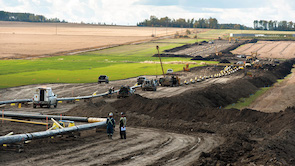In the midst of all the heightened business promotion of new LNG terminals for the BC coast, the hidden impact of gas extraction seems to have been forgotten. But thousands of people, not to mention livestock and wildlife, are subject to the health impacts of the fracking process that extracts the gas.
The Canadian Association of Physicians for the Environment and the American Physicians for Social Responsibility are outspoken on the impacts. In fact, the Science of Birth Centre at the University of British Columbia sponsored a webinar June 10 on the latest findings of impacts on women and infants. Studies show links between fracking sites and acute childhood leukemia, premature birth, low birth weight, and lifelong health consequences.
Banned in Europe
Fracking, or hydraulic fracturing, is the process of pouring pressurized sand, water, and assorted chemicals into wells and labyrinths of horizontal underground lines to extract oil and gas. The technique is banned in numerous EU countries, including Germany, France, and Spain, as well as in Australia. It is, however, predominant in North America, especially BC and Alberta; and in North Dakota, Pennsylvania, and Texas in the US.
In May, a report from Physicians for Social Responsibility Colorado revealed widespread non-compliance with Colorado’s oil and gas chemical disclosure law, enacted in 2022, which also banned the use of PFAS (“forever chemicals”) in drilling fluids. The report estimated that at least 30 million pounds of chemicals were injected into 675 non-reporting wells in 21 months.
Voluntary reporting
In Canada, the only public reports on chemicals used in fracking are voluntarily listed on www.fracfocus.ca, a website run by the resource departments and regulatory agencies of the various provinces and territories, including the BC Oil and Gas commission. However, the information contains many exemptions. It is difficult to compare to National Pollutant Release Inventory (NPRI) units of measurement, and public exposure remains unknown.
Now, a working group is renewing calls to the federal government to add fracking chemicals to the NPRI to advance communities’ right to know. Currently, fracking is considered part of the oil and gas extraction process, which is exempt from NPRI reporting. The expansion of the industry has concentrated wells in Northeast BC and Northwest Alberta, often close to residential neighbourhoods. Proposed LNG plants on the BC coast could soon increase that concentration extensively, with the accompanying use of water and sand, and the release of a mix of largely-unknown chemicals to air and land and water.
At this point, it has been determined that 48 chemicals listed on Canada’s NPRI are used in fracking, as reported to fracfocus.ca, although vast amounts of products are labelled “trade secrets” and not disclosed. The NPRI has mechanisms to force companies to reveal those trade secrets, even if only to government officials.
The latest report on why the Canadian government needs to list fracking chemicals on the NPRI is available at www.watershedsentinel.ca/npri.
 For more information on fracking, health, and the environment, including extensive links to resources and reports, see our Fracking BC: Report from the People Webinar Series.
For more information on fracking, health, and the environment, including extensive links to resources and reports, see our Fracking BC: Report from the People Webinar Series.




